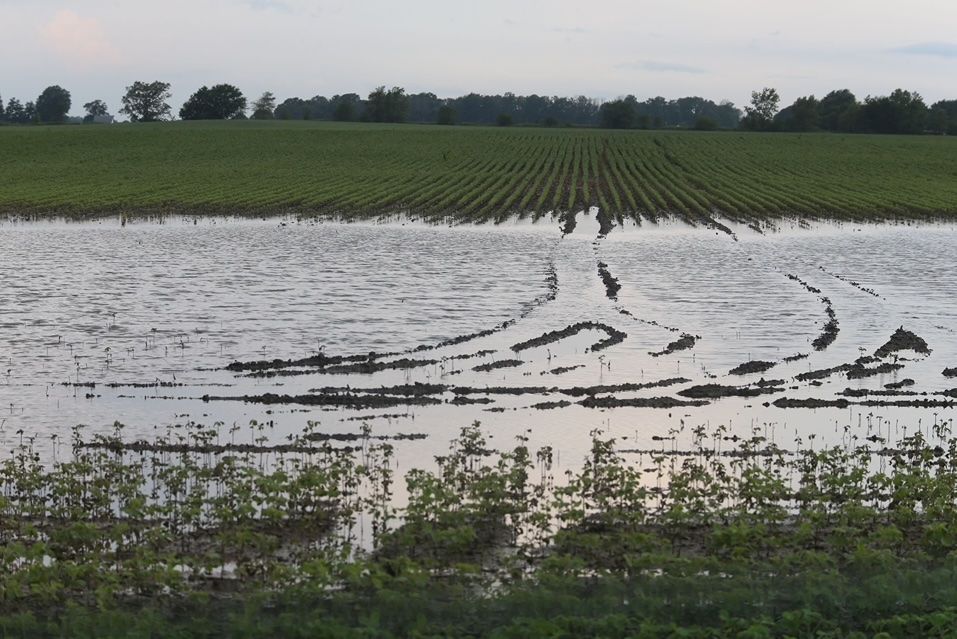As Waters Recede: Recommendations and Resources for Flood Recovery

Spring 2019.
It’s a season — and likely a year — countless farmers would like to forget.
The snows and rains just kept coming. And coming. And coming. Rivers, lakes and creeks kept rising. And rising. And rising.
Levees failed. Planted fields drowned. Nutrients washed away.
In some areas, this cycle repeated more than once.
When the water — and the 2019 season — eventually recede, a new landscape will be left behind. Fields and farms will change as farmers manage recovery and look for ways to mitigate future risk for 2020 and beyond.
Real Challenges
Meagan Kaiser, a soy checkoff farmer-leader, farms with her husband’s family near Norborne, Missouri. Most of their fields lay within 5 miles of the Missouri River, streaked with small creeks that drain into the river.
“We had floods crest three times this year,” she says. “We had high water in March from the catastrophic floods across the Central Plains. Much of that water was from our creeks, which couldn’t drain into the Missouri.”
Because of their soil and water management, they were able to efficiently clean up fields and plant corn in April.
“In May, it rained every three days, and the Missouri River crested again during the third week of the month, covering much of our April corn,” she continues. “The water dropped, but as rains kept coming for us and upriver, saturated levees were at risk.”
Late spring brought more difficulty. “On May 31, the levee near Norborne protecting our land broke, and our fields flooded again,” Kaiser says. “As water continues to be released from reservoirs far upstream and the levee can’t be repaired, this water may not recede until late summer.”
Similar stories are repeated throughout the central U.S.
“We had water in places that haven’t flooded for at least 35 years,” says John Longley, who farms near Aledo, Illinois, less than 15 miles east of the Mississippi along a small tributary, the Edwards River.
“Though nearby levees weren’t topped, it was close. The levees hold at 25 feet, and that’s where the water crested,” Longley reports. “We’ve had similar issues, but never over such a broad area.”
Aaron Nygren, University of Nebraska-Lincoln Extension educator for Colfax, Cuming and Stanton Counties in northeast Nebraska, works with farmers who dealt with flooding along the Platte and Elkhorn Rivers.
“Our big flood was in March,” he says. “We’ve seen some water rising since then, but most damage was done in early spring.”
Planted acres and losses from 2019 flooding vary widely — from farmers like Longley who lost 25 acres but was able to plant most ground, to those like Kaiser who lost most early plantings and had just 75 acres planted by mid-June. Regardless of circumstances, farmers are ready to move ahead.
“We want to look forward,” Kaiser says. “We are asking questions to improve our farm. How can we be more proactive to help the next generation weather these kinds of challenges? How can we work together to protect valuable farmland?”
Assess the New Landscape
These widespread, longstanding floods will change fields.
“The floodwaters in our fields had a current, so we expect erosion and changes to our fields,” Kaiser says. “We may need to adjust waterways or create new ones to adapt to those changes.”
Nygren says farmers can start by assessing sand and silt deposits, erosion and debris caused by the flooding.
“Sand or silt deposits less than 2 inches deep can be worked into the soil with regular fieldwork,” he says. “Deposits that are 2 to 8 inches deep need to be incorporated into fields with a chisel or plow. And deposits deeper than that should be moved, but the equipment and costs for that are much more involved.”
Erosion leaves behind new holes and gullies that need to be filled or worked into water management plans. Floodwaters may wash away crop residue or bring in piles of crop and other debris from upstream, changing soil content, structure and health.
“Farmers need to determine the extent of the damage and available equipment and resources to address that damage,” Nygren says. “Then they can prioritize recovery efforts.”
He recommends checking flooded fields that did get planted in 2019 again after harvest. Then develop a plan to address the damage and changes. New soil samples can guide this plan, especially in fields that require significant repairs.
“It may take a long time to repair field damage, especially in no-till fields that need to be worked,” he continues. “Regardless of history, fields with extensive erosion or sediment damage may need to be smoothed out to prepare for the 2020 crop.”
Kaiser plans to do grid soil sampling when the water recedes to measure the changes in their fields. She plans to start with a clean slate, drawing on successful past experience to rebuild soil structure and health.
“Although the water-holding capacity, soil structure and nutrient levels will have changed after being underwater for months, we know what management practices got us to the point where we can effectively handle heavy rains,” she says. “Once we measure what we have, we will be able to plan how to restore and improve our soils in the coming years.”
She notes patience will be key as the water goes down. “The ground will be completely saturated,” she explains. “We need to stay out of the fields until the ground can handle equipment without compaction, which would make the situation harder.”
Find Resources for Support
With such widespread, extensive damage, many farmers need help.
“We’re thankful for a strong crop insurance program to help us survive this year, as we may not have a harvest,” says Kaiser. “But we realize not everyone will be able to rely just on crop insurance to stay in business.”
The U.S. Department of Agriculture provides useful resources such as the Disaster Assistance Discovery Tool and flood prevent plant provisions to help farmers understand support options.
State resources also exist throughout regions affected by flooding. For example, Nygren says Nebraska Extension has held meetings across Nebraska to help farmers understand available programs for disaster relief. As details about the 2019 disaster aid package have been defined, such meetings help farmers understand options available to them.
Nebraska Extension also provides a wide variety of agronomic flood resources online. Other state Extension services supply similar local recommendations for flood recovery.
Many local communities also offer support to farmers impacted by flooding. Beyond the sandbagging and levee monitoring that brought communities together during the heart of the floods, manpower to repair land, buildings, fencing and more may be available.
Mitigate Current and Future Risk
As farmers impacted by flooding look at the rest of this season, 2020 and beyond, several considerations help manage risk. These individual efforts reduce risk and improve a farm’s ability to recover.
Short-term considerations for flooded fields that were planted include unexpected pest pressures from flooding or weather conditions. Nygren says scouting, especially for disease, is critical. Saturated soils promote soybean diseases. Fields with a history of diseases are at an even greater risk.
Standing water impacts soil health. Nygren explains that flooding can kill soil microbes, impacting future crop growth.
“If the water went down relatively quickly, soybeans should have no problems with rhizobia and nodulation,” says Nygren. “But if floodwater sits on a field for a month or more, consider adding an inoculant for replants or next season to ensure nodulation.”
For fields that didn’t get planted this season, growing anything helps soils recover from this post-flood syndrome.
“We recommend that farmers consider planting a cover crop when able to access prevent-plant fields to stimulate soil recovery from flooding,” he says. “The more time fields have something growing on them, the better off the soil will be.”
Long term, climatologists talk about increasing resiliency to manage shifting weather patterns and increases in severe events.
“Farmers can develop a system that improves the resiliency of their assets, including land, and that will improve the resiliency of their business,” explains Nygren. “Management practices like cover crops and more diverse cropping systems fit into this type of a system and help protect soil. Most farmers have already upgraded equipment to manage small fieldwork windows, as demonstrated by how quickly planting occurred when conditions finally allowed it.”
In Missouri, Kaiser’s in-laws took a unique approach to minimizing their risks and improving their resiliency, which has benefited the current generation.
“After the 1993 flood, they put all their grain and equipment storage at a farm site that didn’t flood,” Kaiser explains. “The site includes temporary living quarters. It allows them to manage floods more easily. When the levee failed, they had just part of a day to move to higher ground. Having grain and farm equipment already on high ground made a big difference.”
Collaboration for Improvement
Similarly, Kaiser wants to use the 2019 flood to prepare the next generation to manage future challenges. Collaboration for water management is one area she sees room for improvement.
“We need to work with a variety of stakeholders to develop a plan that better protects valuable farmland in flood events,” she says.
The levee protecting Kaiser’s fields was one of more than 50 levees that failed during these floods. The Missouri River system covers a large area through many states, and many communities, agencies and industries have an interest in how excess water is managed.
“Weather events impact the whole system,” she says. “But together we can develop management strategies that spread the risks and the costs. Right now, farmers — especially downstream — are bearing disproportionate costs.”
Kaiser has observed that a heavy rain in Kansas City, about 60 miles west and upriver, significantly raises water levels in her area.
“Changing land use and development impacts how water drains,” she explains. “I hope we can use this opportunity to learn to better manage risk for everyone.”
As Kaiser and other farmers work to get through the difficult 2019 season, there is also the future to consider. Finding opportunities to improve resiliency and minimize risk can change the storyline for the next generation’s major flood.



